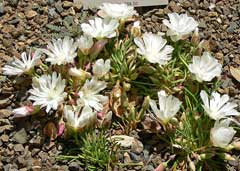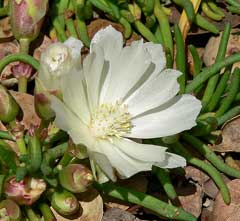 |
|
http://commons.wikimedia.org/wiki/User:Stan_Shebs |
 |
| http://commons.wikimedia.org/wiki/User:Stan_Shebs |
Translate this page:
Summary
Physical Characteristics

 Lewisia rediviva is a PERENNIAL growing to 0.1 m (0ft 4in) by 0.1 m (0ft 4in).
Lewisia rediviva is a PERENNIAL growing to 0.1 m (0ft 4in) by 0.1 m (0ft 4in).
See above for USDA hardiness. It is hardy to UK zone 4 and is not frost tender. It is in leaf from September to July, in flower in June. The species is hermaphrodite (has both male and female organs).
Suitable for: light (sandy) and medium (loamy) soils and prefers well-drained soil. Suitable pH: mildly acid, neutral and basic (mildly alkaline) soils. It cannot grow in the shade. It prefers moist soil.
UK Hardiness Map
US Hardiness Map
Synonyms
L. alba.
Plant Habitats
Cultivated Beds;
Edible Uses
Edible Parts: Root
Edible Uses:
Root - cooked[2, 4, 94, 161]. The root was a staple food of some native North American Indian tribes[257]. It is said to be extremely nutritious, 50 - 80 grams being sufficient to sustain an active person for a day[4, 207]. The root is, however, rather small and tedious to collect in quantity[207]. It is easiest to use when the plant is in flower in the spring, because the outer layer of the root (which is very bitter) slips off easily at this time of the year[85, 95]. Whilst being boiled the roots become soft and swollen and exude a pink mucilaginous substance[183]. The root swells to about 6 times its size and resembles a jelly-like substance[105]. The root has a good taste though a decided bitter flavour develops afterwards[85]. If the root is stored for a year or two the bitterness is somewhat reduced[183]. The root can also be dried, ground into a powder and used as a mush or a thickener in soups etc[212, 257].
References More on Edible Uses
Medicinal Uses
Plants For A Future can not take any responsibility for any adverse effects from the use of plants. Always seek advice from a professional before using a plant medicinally.
Blood purifier Cardiac Galactogogue Poultice
The root is cardiac and galactogogue[257]. An infusion of the root has been used to increase the milk flow in nursing mothers, to relieve heart pain and the pain of pleurisy and also as a blood purifier[257]. The root has been eaten raw to counteract the effects of poison ivy rash and as a treatment for diabetes[257]. The pounded dry root has been chewed in the treatment of sore throats[257]. A poultice of the raw roots has been applied to sores[257].
References More on Medicinal Uses
The Bookshop: Edible Plant Books
Our Latest books on Perennial Plants For Food Forests and Permaculture Gardens in paperback or digital formats.

Edible Tropical Plants
Food Forest Plants for Hotter Conditions: 250+ Plants For Tropical Food Forests & Permaculture Gardens.
More

Edible Temperate Plants
Plants for Your Food Forest: 500 Plants for Temperate Food Forests & Permaculture Gardens.
More

More Books
PFAF have eight books available in paperback and digital formats. Browse the shop for more information.
Shop Now
Other Uses
References More on Other Uses
Cultivation details
Requires a very well-drained gritty humus-rich deep soil in a sunny position[1, 200]. This species is not reliably hardy in Britain. It can withstand consistently very cold weather but does not like alternating periods of mild and cold conditions, nor does it like winter wet[1]. The plant is very susceptible to rotting at the neck in a damp soil[200]. The plant is easy to kill by over-watering but extremely difficult to kill by under-watering. Roots that have been dried and stored for a number of years have been known to come back into growth when moistened[95]. The plant dies down after flowering and re-appears in September. It must be kept dry whilst dormant[129]. It is best grown in a greenhouse or bulb frame[200]. A very ornamental plant[1], it is the state flower of Montana[85, 95]. Very apt to hybridize with other members of this genus[1].
References Carbon Farming Information and Carbon Sequestration Information
Temperature Converter
Type a value in the Celsius field to convert the value to Fahrenheit:
Fahrenheit:
The PFAF Bookshop
Plants For A Future have a number of books available in paperback and digital form. Book titles include Edible Plants, Edible Perennials, Edible Trees,Edible Shrubs, Woodland Gardening, and Temperate Food Forest Plants. Our new book is Food Forest Plants For Hotter Conditions (Tropical and Sub-Tropical).
Shop Now
Plant Propagation
Seed - best sown as soon as it is ripe in a cold frame in a very freely draining soil[129]. Sow stored seed as soon as possible in a cold frame. One months cold stratification should improve germination, though this is still likely to be very slow. When they are large enough to handle, prick the seedlings out into individual pots and grow them on in the greenhouse for at least their first two winters. Plant them out into their permanent positions in late spring or early summer, after the last expected frosts. Division in March/April. Very difficult.
Other Names
If available other names are mentioned here
Native Range
NORTHERN AMERICA: Canada (British Columbia (south)), United States (Colorado (north), Idaho, Montana, Oregon, Washington, Wyoming, Arizona, California, Nevada, Utah)
Weed Potential
Right plant wrong place. We are currently updating this section.
Please note that a plant may be invasive in one area but may not in your area so it's worth checking.
Conservation Status
IUCN Red List of Threatened Plants Status :

Growth: S = slow M = medium F = fast. Soil: L = light (sandy) M = medium H = heavy (clay). pH: A = acid N = neutral B = basic (alkaline). Shade: F = full shade S = semi-shade N = no shade. Moisture: D = dry M = Moist We = wet Wa = water.
Now available:
Food Forest Plants for Mediterranean Conditions
350+ Perennial Plants For Mediterranean and Drier Food Forests and Permaculture Gardens.
[Paperback and eBook]
This is the third in Plants For A Future's series of plant guides for food forests tailored to
specific climate zones. Following volumes on temperate and tropical ecosystems, this book focuses
on species suited to Mediterranean conditions—regions with hot, dry summers and cool, wet winters,
often facing the added challenge of climate change.
Read More
Expert comment
Author
Pursh.
Botanical References
60200270
Links / References
For a list of references used on this page please go here
Readers comment
© 2010, Plants For A Future. Plants For A Future is a charitable company limited by guarantee, registered in England and Wales. Charity No. 1057719, Company No. 3204567.